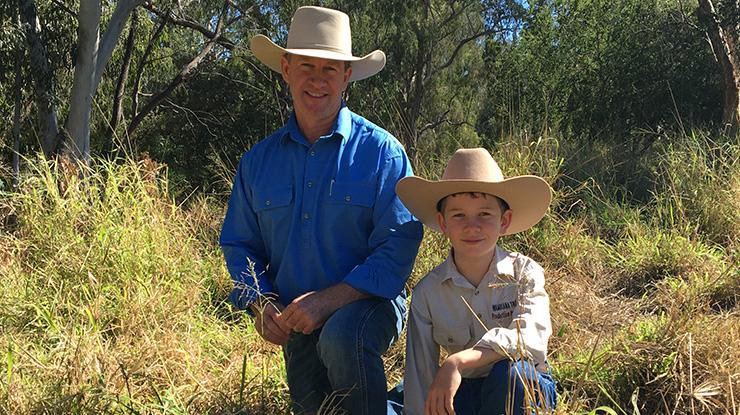Spelling for success
03 September 2020
 Michael Lyons and his son Hugh at Wambiana Station, Charters Towers.
Michael Lyons and his son Hugh at Wambiana Station, Charters Towers.
Michael and Michelle Lyons have turned their first‑hand experience of a long‑term grazing trial on their family’s Charters Towers station into an opportunity to improve pasture management in a highly variable climate.
The Queensland government first leased part of ‘Wambiana Station’ from Michael’s parents in 1997 to test and develop sustainable, profitable strategies to manage rainfall variability in extensive grazing enterprises. These trials continue to be run by the Queensland Department of Agriculture and Fisheries (DAF).
“We’ve taken the results from the trials and put them into practice in a rotational grazing strategy,” Michael said.
The Lyonses use rotational grazing to spell paddocks more successfully. Combined with carefully adjusting stocking rates to match their seasons, this allows them to better look after desirable grasses. As a result, they only use about 30% of their property at any one time.
“We move the cattle through paddocks quickly in the wet season to ensure they only lightly graze the better grasses, giving them time to recover before grazing again in the dry season.
“This rations out the feed, ensuring the pastures left behind are in good condition and ready to respond to the coming wet season.”
Michael said wet season spelling is also a crucial tool to achieve animal production targets and set up pastures for the dry season.
“By the time we get to the dry season, we know how much grass we have to work with. “From this we can determine our dry season plan and whether we’ll need to adjust our stock numbers to match the feed available.”
Infrastructure is key
Michael said effective spelling and rotational grazing requires the right infrastructure.
“We found we needed to spread our water points across the property to allow better grazing distribution and forage utilisation,” he said.
“Now our cattle don’t need to walk more than 1.5km to get a drink of water.
“This ensures we can spell the country we want to, rather than moving to paddocks based on whether or not there is surface water available.”
The Lyonses also invested in fencing so cattle can be moved away from their preferred areas to graze paddocks more evenly, and to help manage riparian country during the wet season.
Michael said sound knowledge and confidence were important factors in changing their management practices to spell country more effectively.
“We’ve actively sought training in grazing strategies through programs such as MLA’s EDGE courses and RCS Grazing for Profit,” Michael said.
“We’ve also recently started to use MaiaGrazing, an online grazing chart, to record our grazing and deliver information on how our paddocks are yielding, plus give us early indications on how we are tracking relative to our carrying capacity benchmarks.”
|
Lessons learned
|


